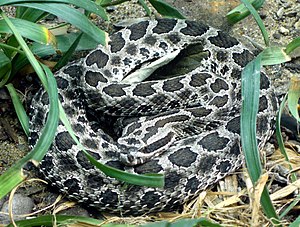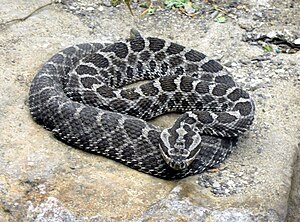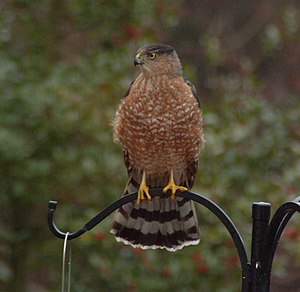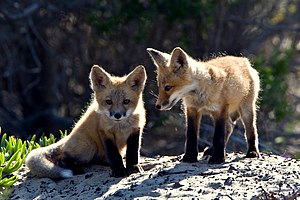
Have you ever ever heard of an Eastern massasauga rattlesnake? Or a Sistrurus catenatus?
Me either.
Until recently.
I’ve just come across notes that I scribbled almost three years ago on May 15, 2009 after seeing a large, unfamiliar snake behind the carriage barn. I tried to identify the exotic serpent but never solved the mystery.
My sleuthing was reinvigorated this afternoon, leading me to a new possibility. As unlikely as it may seem, I now suspect that I may have spotted a massasauga rattlesnake with markings totally unlike our local Adirondack timber rattlesnakes.
But I’m getting ahead of myself. First let’s take a look at my old notes:
After gardening, while watering transplanted tomatoes I saw a large snake with unfamiliar coloring/markings. I described it to naturalist John Davis (@trekeast), conservationist Chris Maron and Essex Farm guru, Mark Kimball. No consensus. Perhaps a copper head, a northern water snake or an adder. I poked around the web looking at photos and reading descriptions. It was not a Northern Water Snake. The Northern Copperhead photo could be a match, and the description fits quite accurately. And this photo of a copperhead looks similar. Actually, most photos I find online of Northern Copperheads look similar:
- another copperhead
- two copperheads
Some other possibilities include Eastern Fox Snake, Northern Water Snake and Corn Snake. In fact, it looked an awful lot like a, Anerythristic Corn Snake (Elaphe guttata), but we’re definitely not in their natural range. Here’s a photo of a baby corn snake that is much smaller than the stealthy serpent I spied, though otherwise very similar. And here’s another corn snake. This photo of an Anerythristic Corn Snake is a dead ringer for the rhubarb runaway.
That was my thinking three years ago. But I’ve changed my mind. If only I had a photograph…
At the time I called my bride on my mobile phone and asked her to bring my camera so I could take a picture. “Come quick. I don’t want the snake to get away!”

“Don’t get near it. It’s probably a rattlesnake.Come inside. Now.”
A brief, anxious verbal volley later the snake had vanished into the deep grass around the rhubarb patch. No photograph. Though the image of the snake — pale yellowish tan background with brown and black foreground markings — lingered in my mind, the length of the snake grew longer with each passing minute.
The timber rattlesnakes that live in the Adirondacks are dark, almost black with only a faint pattern visible in certain lighting situations. This snake was not a timber rattlesnake. And I never saw a rattle. Nor did I hear a rattle.
And yet when I stumbled upon the photographs of the yellow rattlesnake above, I instantly recognized the snake that vanished in the rhubarb patch. We had a Sistrurus catenatus, yellow massasauga rattler in Rosslyn’s rhubarb patch!
Or did we?
What if the assumption that all Adirondack timber rattlesnakes living in the Split Rock Mountain Forest area are brown-black is erroneous? What if some of our local rattlers look like the yellowish tan snakes in this video which was ostensibly filmed in New York Sate?
The photographer/videographer who shared that dramatic footage was prudent not to disclose the location of the snakes, but I wouldn’t be surprised if they were right here in the Champlain Valley. Those pale snakes, especially the rattlesnake with the pale yellow head are extremely similar to my rhubarb patch mystery serpent!
If you’re a wise herpetologist with a knowledge of the Adirondacks’ Champlain Valley maybe you can help solve my snake mystery…
Updates
June 27, 2012: Perhaps Bill Brown (and many others) are relying upon empirical evidence about the Split Rock rattlesnakes that is changing?
Bill Brown, an expert on timber rattlers… said the Split Rock population is unusual in that all the specimens are black. Except for a tiny population in New Hampshire, other populations in the North are made up of black snakes and yellow snakes (with crossbands)… A biologist who has studied timber rattlers for more than three decades, Brown attributes the uniformity of the Split Rock population to the “founder effect.” It is supposed that all the founders of the population were black, and no yellow snakes contributed to the gene pool. (Adirondack Explorer)
July 17, 2012: Seems that we need help identifying another mystery snake in the Adirondacks.
https://twitter.com/Davecfm/status/223131416618209280

Or, if my eyes serve me, two Adirondack mystery snakes.
Thanks, Dave Cummings (@Davecfm), for adding more serpentine curiosity to the mix!
If you’re interested in building a timber frame home, you need to check this guy out. Cummings shares photographic documentation of his quest to build an off-the-grid, timber frame and straw bale house just south of us, near Bolton Landing.
I missed Cummings’ first Twitter post about the snake(s), but this Northern Water Snake follow-up tweet by Jake (@darkeyes924) got my attention. Better late than never!
@Davecfm @virtualDavis It looks like a Northern Water Snake.
— Jake (@darkeyes924) July 16, 2012
Hmmm… Might be. Looks like two snakes actually! RT @darkeyes924: @Davecfm It looks like a Northern Water Snake.
— virtualDavis (@virtualDavis) July 16, 2012
@trekeast, can you shed any light on these snakes? http://t.co/RCbgsjCc
— Rosslyn Redux (@RosslynRedux) July 16, 2012
https://twitter.com/TrekEast/status/224966236382044161

https://twitter.com/TrekEast/status/224973177439260673
https://twitter.com/TrekEast/status/224978430666612736
Yes & yes. RT @TrekEast With your mystery snake, did you notice head shape? Pit vipers, including rattlesnakes, have diamond-shaped heads…
— virtualDavis (@virtualDavis) July 16, 2012
https://twitter.com/TrekEast/status/225174561753284609
Mystery [possibly] solved. Thanks! RT @trekeast Wildlands biologist thinks Northern Water Snake & Eastern Garter Snake (rear) …
— Rosslyn Redux (@RosslynRedux) July 17, 2012
October 9, 2014:
Recently I was contacted by a herpetologist here in NY studying the Massasauga who was interested in my observation. In our discussion he mentioned this:
It is common for Milksnakes to be identified as Massasaugas. The belief is that Milk snakes have evolved to mimic venomous species in their area, and in eastern states are known to be EMR mimics. Is it possible what you saw was a Milk Snake? ~Alexander Robillard of SUNY College of Environmental Science and Forestry
So, it’s quite likely that I saw an enormous, beautiful milk snake. I’ve seen no similar snakes recently or ever. And given the fact that our local population of rattlesnakes (Split Rock Wilderness) are apparently all blackish, this suggestion seems the most likely.
 Essex from the ice, March 13, 2015 (Source: Bill Amadon)[/caption]
Essex from the ice, March 13, 2015 (Source: Bill Amadon)[/caption]


























